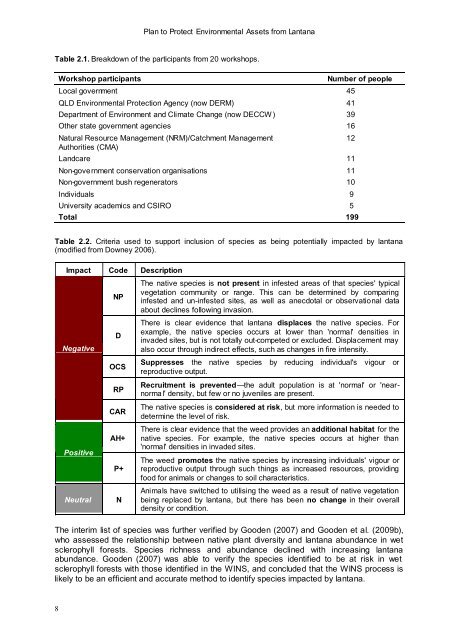Plan to Protect Environmental Assets from Lantana - Weeds Australia
Plan to Protect Environmental Assets from Lantana - Weeds Australia
Plan to Protect Environmental Assets from Lantana - Weeds Australia
Create successful ePaper yourself
Turn your PDF publications into a flip-book with our unique Google optimized e-Paper software.
<strong>Plan</strong> <strong>to</strong> <strong>Protect</strong> <strong>Environmental</strong> <strong>Assets</strong> <strong>from</strong> <strong>Lantana</strong><br />
Table 2.1. Breakdown of the participants <strong>from</strong> 20 workshops.<br />
Workshop participants<br />
Local government 45<br />
QLD <strong>Environmental</strong> <strong>Protect</strong>ion Agency (now DERM) 41<br />
Department of Environment and Climate Change (now DECCW ) 39<br />
Other state government agencies 16<br />
Natural Resource Management (NRM)/Catchment Management<br />
Authorities (CMA)<br />
Landcare 11<br />
Non-government conservation organisations 11<br />
Non-government bush regenera<strong>to</strong>rs 10<br />
Individuals 9<br />
University academics and CSIRO 5<br />
Total 199<br />
Number of people<br />
12<br />
Table 2.2. Criteria used <strong>to</strong> support inclusion of species as being potentially impacted by lantana<br />
(modified <strong>from</strong> Downey 2006).<br />
Impact Code Description<br />
Negative<br />
Positive<br />
Neutral<br />
NP<br />
D<br />
OCS<br />
RP<br />
CAR<br />
AH+<br />
P+<br />
N<br />
The native species is not present in infested areas of that species' typical<br />
vegetation community or range. This can be determined by comparing<br />
infested and un-infested sites, as well as anecdotal or observational data<br />
about declines following invasion.<br />
There is clear evidence that lantana displaces the native species. For<br />
example, the native species occurs at lower than 'normal' densities in<br />
invaded sites, but is not <strong>to</strong>tally out-competed or excluded. Displacement may<br />
also occur through indirect effects, such as changes in fire intensity.<br />
Suppresses the native species by reducing individual's vigour or<br />
reproductive output.<br />
Recruitment is prevented—the adult population is at 'normal' or 'nearnormal'<br />
density, but few or no juveniles are present.<br />
The native species is considered at risk, but more information is needed <strong>to</strong><br />
determine the level of risk.<br />
There is clear evidence that the weed provides an additional habitat for the<br />
native species. For example, the native species occurs at higher than<br />
'normal' densities in invaded sites.<br />
The weed promotes the native species by increasing individuals' vigour or<br />
reproductive output through such things as increased resources, providing<br />
food for animals or changes <strong>to</strong> soil characteristics.<br />
Animals have switched <strong>to</strong> utilising the weed as a result of native vegetation<br />
being replaced by lantana, but there has been no change in their overall<br />
density or condition.<br />
The interim list of species was further verified by Gooden (2007) and Gooden et al. (2009b),<br />
who assessed the relationship between native plant diversity and lantana abundance in wet<br />
sclerophyll forests. Species richness and abundance declined with increasing lantana<br />
abundance. Gooden (2007) was able <strong>to</strong> verify the species identified <strong>to</strong> be at risk in wet<br />
sclerophyll forests with those identified in the WINS, and concluded that the WINS process is<br />
likely <strong>to</strong> be an efficient and accurate method <strong>to</strong> identify species impacted by lantana.<br />
8

















